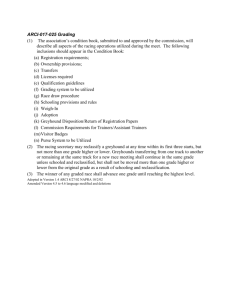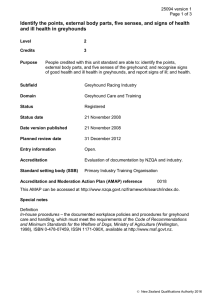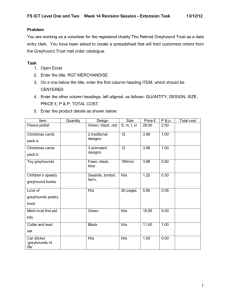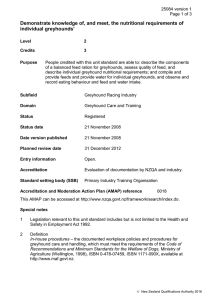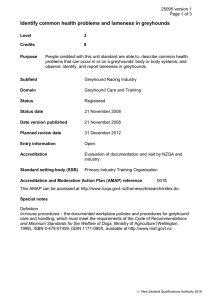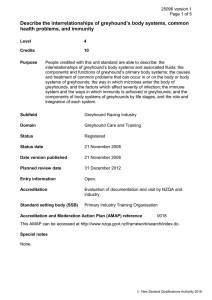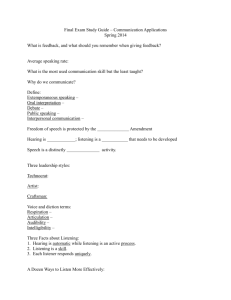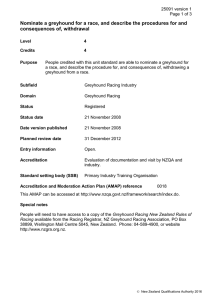Describe the pre-training, conditioning, and associated feeding and
advertisement
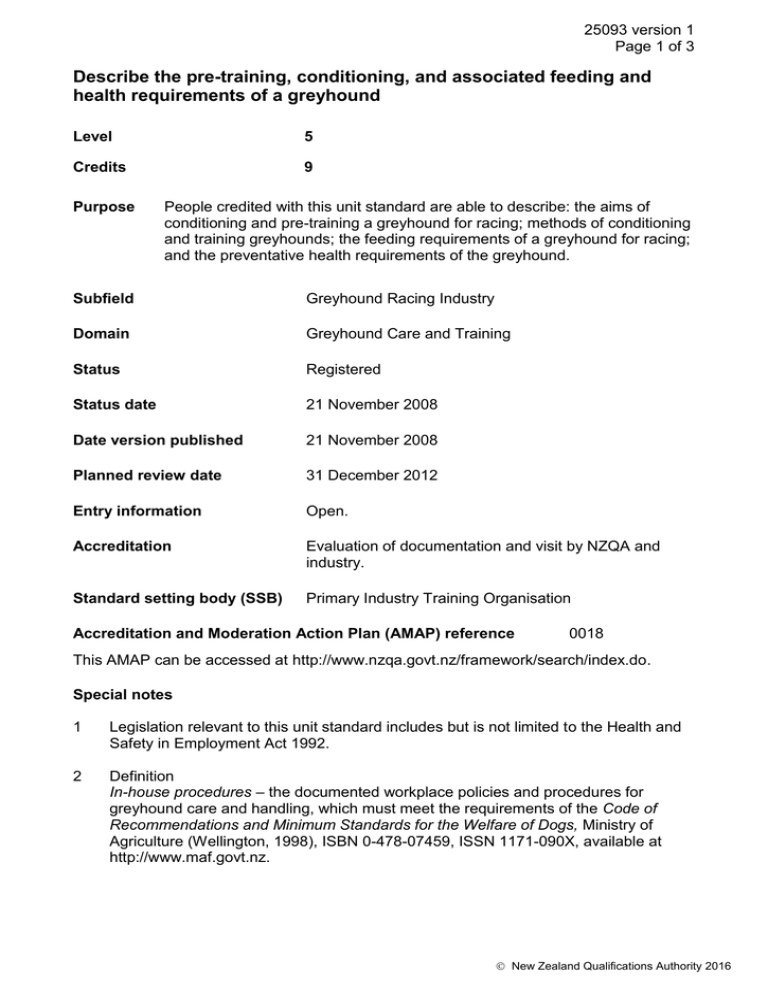
25093 version 1 Page 1 of 3 Describe the pre-training, conditioning, and associated feeding and health requirements of a greyhound Level 5 Credits 9 Purpose People credited with this unit standard are able to describe: the aims of conditioning and pre-training a greyhound for racing; methods of conditioning and training greyhounds; the feeding requirements of a greyhound for racing; and the preventative health requirements of the greyhound. Subfield Greyhound Racing Industry Domain Greyhound Care and Training Status Registered Status date 21 November 2008 Date version published 21 November 2008 Planned review date 31 December 2012 Entry information Open. Accreditation Evaluation of documentation and visit by NZQA and industry. Standard setting body (SSB) Primary Industry Training Organisation Accreditation and Moderation Action Plan (AMAP) reference 0018 This AMAP can be accessed at http://www.nzqa.govt.nz/framework/search/index.do. Special notes 1 Legislation relevant to this unit standard includes but is not limited to the Health and Safety in Employment Act 1992. 2 Definition In-house procedures – the documented workplace policies and procedures for greyhound care and handling, which must meet the requirements of the Code of Recommendations and Minimum Standards for the Welfare of Dogs, Ministry of Agriculture (Wellington, 1998), ISBN 0-478-07459, ISSN 1171-090X, available at http://www.maf.govt.nz. New Zealand Qualifications Authority 2016 25093 version 1 Page 2 of 3 3 For this unit standard the practical assessment evidence must be provided in the context of a commercial greyhound business operation under normal working conditions. Elements and performance criteria Element 1 Describe the aims of conditioning and pre-training a greyhound for racing. Performance criteria 1.1 Conditioning and pre-training are described in terms of development of the greyhound to improve fitness and balance. Range 1.2 develop – mental attitude, co-ordination, speed; simulate competition situation, improve response to stimuli. Conditioning and pre-training are described in terms of the effects on the greyhound’s body systems. Range muscles, bones, tendons, ligaments, cardiovascular, respiratory. Element 2 Describe methods of conditioning and training greyhounds. Performance criteria 2.1 Methods of conditioning and training are described in terms of their suitability for individual greyhound requirements. Range 2.2 Psychological requirements are described in terms of the stages of training. Range 2.3 beach work, road work, hill work, flat work, jumping, in company, alone, in hand, loose, bullring, straight, enclosed area, start box, racetrack, qualifying trial. individual greyhound needs, routine, changes to routine, kennelling and yarding, handler. Nutritional requirements are described in terms of the contents of the components of a balanced ration according to the individual greyhound and its stage of training. New Zealand Qualifications Authority 2016 25093 version 1 Page 3 of 3 Element 3 Describe the feeding requirements of a greyhound for racing. Performance criteria 3.1 Nutritional requirements of greyhounds are described in terms of stage of training and activity. Range work days, rest days. 3.2 Feeds are identified and selected to meet nutritional requirements according to activity. 3.3 A balanced ration to meet all greyhound nutritional requirements is formulated. 3.4 A balanced ration is introduced to allow the greyhound to obtain maximum benefit from the feed in accordance with in-house procedures. Element 4 Describe the preventative health requirements of the greyhound. Performance criteria 4.1 Preventative health requirements are described according to the individual greyhound’s requirements and in-house procedures. Range worming, vaccination. Please note Providers must be accredited by NZQA, or an inter-institutional body with delegated authority for quality assurance, before they can report credits from assessment against unit standards or deliver courses of study leading to that assessment. Industry Training Organisations must be accredited by NZQA before they can register credits from assessment against unit standards. Accredited providers and Industry Training Organisations assessing against unit standards must engage with the moderation system that applies to those standards. Accreditation requirements and an outline of the moderation system that applies to this standard are outlined in the Accreditation and Moderation Action Plan (AMAP). The AMAP also includes useful information about special requirements for organisations wishing to develop education and training programmes, such as minimum qualifications for tutors and assessors, and special resource requirements. Comments on this unit standard Please contact the Primary Industry Training Organisation standards@primaryito.ac.nz if you wish to suggest changes to the content of this unit standard. New Zealand Qualifications Authority 2016
